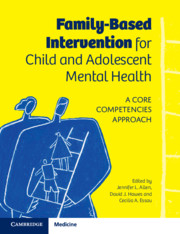Book contents
- Family-Based Intervention for Child and Adolescent Mental Health
- Family-Based Intervention for Child and Adolescent Mental Health
- Copyright page
- Contents
- Contributors
- Preface
- Part I Theoretical Perspectives on Family-Based Intervention
- Part II Core Clinical Competencies
- Chapter 5 Engaging Fathers in Family-Based Interventions for Child Mental Health
- Chapter 6 Cultural Diversity and Family-Based Interventions
- Chapter 7 Delivering Family-Based Interventions Using Phone-Assisted and Internet-Based Technology
- Part III Family Intervention for Specific Child and Adolescent Mental Health Problems
- Part IV Family Intervention for Children at Risk Due to Family Dysfunction or Past Adversity
- Part V New Developments in Family-Based Intervention
- Index
- References
Chapter 7 - Delivering Family-Based Interventions Using Phone-Assisted and Internet-Based Technology
from Part II - Core Clinical Competencies
Published online by Cambridge University Press: 18 February 2021
- Family-Based Intervention for Child and Adolescent Mental Health
- Family-Based Intervention for Child and Adolescent Mental Health
- Copyright page
- Contents
- Contributors
- Preface
- Part I Theoretical Perspectives on Family-Based Intervention
- Part II Core Clinical Competencies
- Chapter 5 Engaging Fathers in Family-Based Interventions for Child Mental Health
- Chapter 6 Cultural Diversity and Family-Based Interventions
- Chapter 7 Delivering Family-Based Interventions Using Phone-Assisted and Internet-Based Technology
- Part III Family Intervention for Specific Child and Adolescent Mental Health Problems
- Part IV Family Intervention for Children at Risk Due to Family Dysfunction or Past Adversity
- Part V New Developments in Family-Based Intervention
- Index
- References
Summary
Technology has proven itself to be invaluable across many disciplines, including psychology. With the rise in technological advancements, services are now can be provided through technological media. This chapter describes tele-mental health (TMH) services, which refer to the supports (e.g., therapy, consultation, intervention, coaching) that are provided in ‘real time’ by practitioners to clients through telephones, cellphones, computers, tablets and any other device that can facilitate communication with the aid of technology. This chapter in particular focuses on TMH services that are facilitated through video-chat interfaces. The origins and evidence base for TMH are included, along with recommendations for ethical and legal considerations, as well as rapport building. Though practitioners may be hesitant to deliver TMH services, the purpose of this chapter is to provide readers with enough information to help prepare them for the field and ease any reservations they may harbor
- Type
- Chapter
- Information
- Family-Based Intervention for Child and Adolescent Mental HealthA Core Competencies Approach, pp. 76 - 86Publisher: Cambridge University PressPrint publication year: 2021
References
- 3
- Cited by



